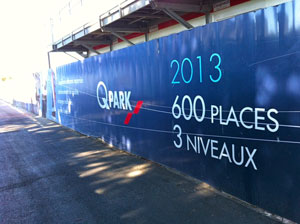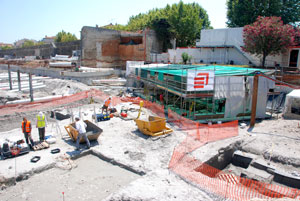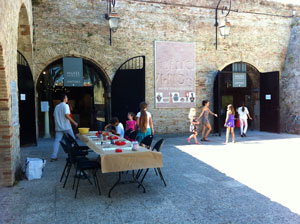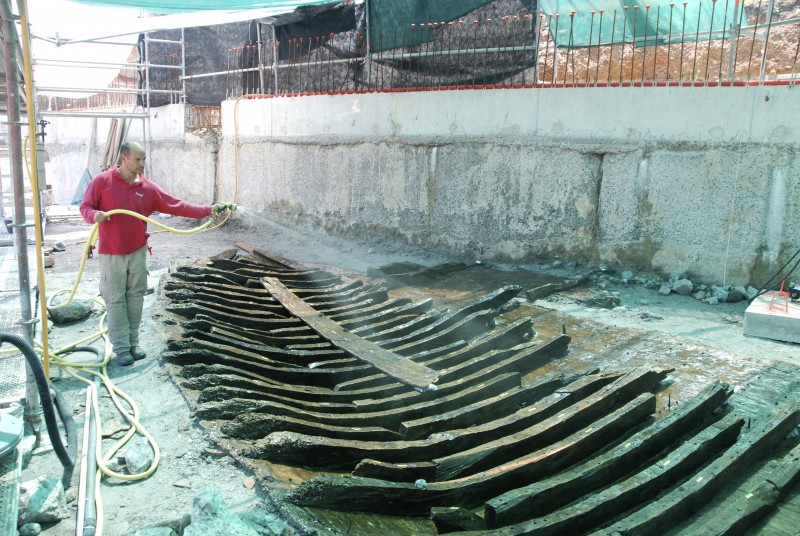The morning as Philippe and I left Antibes on a mini-holiday of our own, heading up to London for the opening of the Olympic Games, he caught this snip on the TV news: Président Hollande asks his ministers to stay in France for their summer holidays.
Vacation home in Spain? Tough luck. Family in Belgium? See you next year.
I’m betting this new ministerial proviso – which, so a British friend quickly pointed out, is akin to something Mr Cameron said last summer – will put even more bodies on the Côte d’Azur’s bursting roads and beaches this summer. It’s simply the latest shove in a well-established trend.
In early July, before the season truly commenced, the local Nice Matin newspaper predicted a large influx into our region this summer. It’d be the best traffic since the economic crisis of 2008, the paper predicted, even if the average visitor would cut corners on expenses. Fierce competition between Air France and easyJet would bring passengers into Nice Côte d’Azur Airport, which already had broken its daily passenger record. All in, the paper said, we’d see around 11 million visitors in the Côte d’Azur this summer, plus another million passengers from cruise ships.
It’s not just the French ministers who are expected this summer. The whole of France seems to be staying home, avoiding traditional hot spots like Tunisia and Morocco where the heat’s just a little too intense these days. Foreigners, too, are looking for a stable destination. Among them, the Yanks were due to make a strong return, thanks to the wobbliness of the Euro. As for the rich and famous, they never really left. Flying into Nice’s airport one afternoon at the beginning of July, we counted 60 private planes. All of them were parked.
These were the summer tourist forecasts, anyway, and they were easy to understand with a glance at France’s weather forecasts. Of all places in the country, the Côte d’Azur has been the place to be. Most days, particularly early in the season, the map of France was cloaked in black clouds and flaccid temperature readings – everywhere from the English Channel to the Pyrenees’ mountaintops, from the Atlantic coastline to the German borders and the capital of bouillabaisse, Marseilles.
Everywhere, that is, except for the Côte d’Azur. The weather forecaster was probably getting bored. “Beaucoup de soleil sur la Côte d’Azur aujourd’hui.” It was getting rather boring. The poor chap never got any new lines. But while this patch of sun-filled paradise was prominent in France, the size of its real estate was petit – like Florida is to the US, Mallorca to Spain, or Hong Kong to China. The Côte d’Azur is a happy footnote.
All of which makes for a marvelous amount of madness in the area – particularly during the high season and especially on the roads. I’m sure that I’m partially immune to the area’s traffic follies because they mount steadily throughout the summer months, playing some odd, walk-on role at the backdrop of the annual, comic drama.
Sometimes it takes an outsider to prick this CDA bubble and remind me of its absurdity. It happened this year, in spades, when the representatives of the real world who visited our Bellevue came equipped with an army of (their own) highly intelligent and verbal children.
Shortly after entering Côte d’Azur traffic space, seven-year-old Paige shouted from the back seat of her family’s airport rental car, “Cars are coming from everywhere! Is this a country with no rules?”
Paige had just spun through her very first rondpoint. The centrifugal force inside the car was surely something, but it probably formed only the dot on her exclamation point.
The roundabout in question was located only minutes from Nice Côte d’Azur Airport. It handled traffic of swerving tourists as well as impatient locals. Within this semi-managed chaos, motorbikes apply their new road privileges with particular grace and agility, slaloming up the center aisle of two lanes of traffic (headed the same direction) in a mad push to get there first.
The roads still being what they may, I must admit that the Nice Matin’s tourism forecasts don’t feel as if they’re panning out. Traffic is frantic, but a bit less so than I remember it. Beaches are busy but a bit less populated. And surely a reflection of the economy, restaurant reservations are hardly a problem.
Our beloved, high-heeled taxi driver Christelle confirmed this notion at the beginning of August. As she drove Philippe and me home from Nice’s airport – in full 12-centimeter heels (I asked) – she declared that this summer was turning out to be “plutôt calme” – rather calm.
Indeed, a quick flick through the Nice Matin over the week I’ve been away shows that the July tourist numbers in neighbouring Cannes were 5 – 10% off last year. Part of the decline is attributed to an early Ramadan as many wealthy Middle Eastern visitors have cut their holidays short. Meanwhile, for the busy month of August, hotels are recording a 70% reservation rate. The president of the regional tourism committee puts a positive spin on the situation – but then he would. We’re not far off last year’s numbers, he says. The president of the hoteliers’ association calls business “rather satisfying.”
But I hardly hear corks popping either. It’s a far cry from the great expectations for summer 2012. And frankly, at least for our hometown of Antibes-Juan-les-Pins, I must say the modest downturn is a good thing, for one simple reason: We have no parking.
Parking is the reason I’ve barely touched our rental car this summer. Instead, I bike.
It took getting out of the Côte d’Azur last week for me to appreciate how gruesome the situation has become this summer. The first thing I did on stepping out of Heathrow Airport – joining the mobs of elbows and backpacks from the 204 countries represented at the Olympic Games – was marvel at how gloriously generous the parking spaces were at London’s biggest transport hub. And that there were actually spaces available.
A couple Saturdays ago, Philippe, seven-year-old Lolo and I drove into Cannes for a memorial service for a church friend. The parking situation was fraught as the church lay just a couple blocks off the city’s long beaches and its famed Croisette shopping boulevard. But we were lucky. One car, just a block and a half from the church, was pulling out.
After the service, Philippe pointed out two parking police on a smoke break in the shade of the opposite building’s entryway. “Only in France!” he said.

Looking right and left, not a single ticket lay on any car’s windscreen. There wasn’t even a ticket smacked on this car parked in the middle of an intersection, just a couple blocks from Cannes’ busiest streets. (Cleverly, the driver had avoided all zebra crossings. Parking on a pedestrian crossing in France is akin to crossing your town’s only boulanger. Life would not be worth living.)
Such is the parking situation in the neighbouring city of Cannes. That there was a ticket on the windscreen of our own car is merely a side note – a 17-Euro fine if we managed to pay it within 45 days. Talk about generous. But then we extrapolated: Parking near the church is free on Sundays. But that was Saturday. The parking police on the smoke break deserved a rest. They’d probably stung half the folks in the church.
And still, Cannes’ parking has nothing on Antibes-Juan-les-Pins’ this summer. In an effort to deal with the cars, our hometown is in the process of tearing up its single-layer parking lots. Oodles of slots are off-limits this summer, sequestered behind the looming walls of construction, obliterated by a massive push to create over 600 new spaces.

It’s short-term pain for long-term gain, right? Then there was news.
At the edge of Antibes’ Old Town, opposite the busy Port Vauban that berths some of the world’s biggest megayachts, cranes inside the Pré-aux-Pêcheurs parking lot were digging into the earth. A three-level, 377-space, underground parking garage was scheduled for delivery before next summer’s crush.
Then in June, the worksite offered up the skeleton of a wooden boat. This glorious new slice of ancient Roman civilization, nestled in the earth just inches off Antibes’ rampart walls, suddenly became the talk of the town – and of journalists and YouTube and the broader community of history buffs. Nothing like this had ever been found along the Mediterranean coastline except in Marseilles, the home of bouillabaisse and, seemingly, ancient boats.

Already measuring 14 meters in length, site archeologists reckoned that the Roman remains could be much bigger. The boat had probably taken 600 trees to build. Questions began to circulate. Who would pay for the boat’s removal and preservation: The city of Antibes? The département of the Alpes-Maritimes? France? The EU? A rumour surfaced that – quelle chance! – another, even older boat might lie beneath the first one!
In a single lurch, Antibes’ parking chaos became more enduring. Indefinite, even.
Luck swung our way. Philippe, Lolo and I managed a personal invitation to view the dig – a good month’s work after all the initial hype. Our friend Jean-Louis, who heads Antibes’ museums, squeezed in a visit for us one lunchtime. We rushed to the site at a moment’s notice. The remaining parking at Port Vauban being chock full (of course), we slid our car into a space that was reservé for some poor boat owner.
Jean-Louis handed us hardhats while an enormous power shovel scooped and swung at the opposite end of the construction site. Soon we were heading into the site floor, treading sand and silt that were a couple thousand years old.

Our friend pointed out the flat, white shells that scattered over the surface. He handed one to Lolo, who brought it to me with obvious delight. Jean-Louis had told her she could garder the shell – and she promised me, on cross-examination, that no, he didn’t say regarder. There’s a fine line, linguistically and otherwise, between observing and keeping such an ancient specimen.
We approached a green canopy in the corner of the worksite, right at the foot of Antibes’ old rampart walls. It sheltered the precious maritime remains. We filed underneath, standing single-file on a piece of plywood at the edge of the archeological site.
A wooden ribcage sprawled on the ground before us, denuded of its earthen blanket for the first time in 2,000 years. Once 20 meters in length, the hull of the boat lay tilted and splayed out on the ground, pressed flat by centuries of sand and feet and horses and cars that had occupied the living centuries above it. Bronze nails poked vertically from the boat’s wooden frame. Bits of metal still bound some of the most important joints. A man sprayed the fragile remains with water as it baked under the green tarp.

Fancy equipment lined the edges of the dig, like a three-dimensional camera that helps archeologists understand the boat’s original form. Along the sides of the carcass were remnants of terracotta vases and pots, still partially buried in earth. Cutting through the edge of the boat’s frame was a cement mound. Workers had sunk a pylon without realizing.
The ship’s construction was very sophisticated, Jean-Louis explained, with its first-rate materials and interwoven wooden joints. It hardly had been a pleasure boat but a vessel used for Mediterranean commerce. I imagined the ceramic pieces reconfigured, laden with olives and their oil, or maybe water or wine. But this venture into Antibes’ ancient port was obviously the boat’s last.

Isabelle, the site’s chief archeologist, joined us later. (The government must employ not only builders on these types of sites but also a whole archeological team.) She explained that this corner of the construction site had been Antibes’ port in 400BC – 600AD. At the current level of the dig, there was a rich history. Shallower layers had carried less interest; the Roman port was choked off by silt during medieval times. It was in these recent months of the modern era, I reflected, that we were digging through the Mediterranean’s history, literally, layer by layer, allowing it to unfold before our eyes.
The next step, we learned, is to remove the Roman boat, piece by piece, from its ancient tomb. Each wooden segment will be saturated with a liquid preservative and frozen. On thawing, the water will evaporate and the wooden structure will be cloaked in the preservative. Or something like that. And then someone will build the boat all over again.

The final product will be too large to occupy Antibes’ nearby Musée d’Archéologie, a couple gorgeous, vaulting chambers carved into Bastion St-André at the base of the old rampart walls. Alternatively, Lolo wondered why the city couldn’t keep the boat where it was and simply build a small museum around the remains. I enjoyed this notion that the boat should retain its two-millennial resting spot, so I launched her idea to Jean-Louis. He laughed. The space was already devoted to parking! The money was spent!
Put another way, modern convenience trumps historic relics, no matter their importance. And given Antibes’ parking situation, I sort of get it.
The Roman boat will take up residence in a former radio station on the edge of town. It’s a large, city building and no one’s using it. The doors should open in three years, give or take.

As for the underground parking garage itself, the cranes are working 24-7. (How many shifts that requires under French labour law, I hardly can calculate.) Completion of the garage is slated for next summer, but the spaces won’t be operable until something like October 2013.
If, just for one more summer, the economy could remain a bit tight? Or less drastically, maybe we could hope for a quick surge in the Euro come next June. Another early Ramadan wouldn’t be a bad thing either, nor would a spot of ministerial holiday leniency or a grand sorting out of the resort towns in North Africa.
Philippe, Lolo and I returned our hardhats and thanked Jean-Louis for organising our visit to the historic find. As we waved goodbye, he scooted off in his car painted with Antibes-Juan-les-Pins’ crest on the front doors.
That car, I realized, had to be the biggest job perk of all. With it, he can park anywhere.

